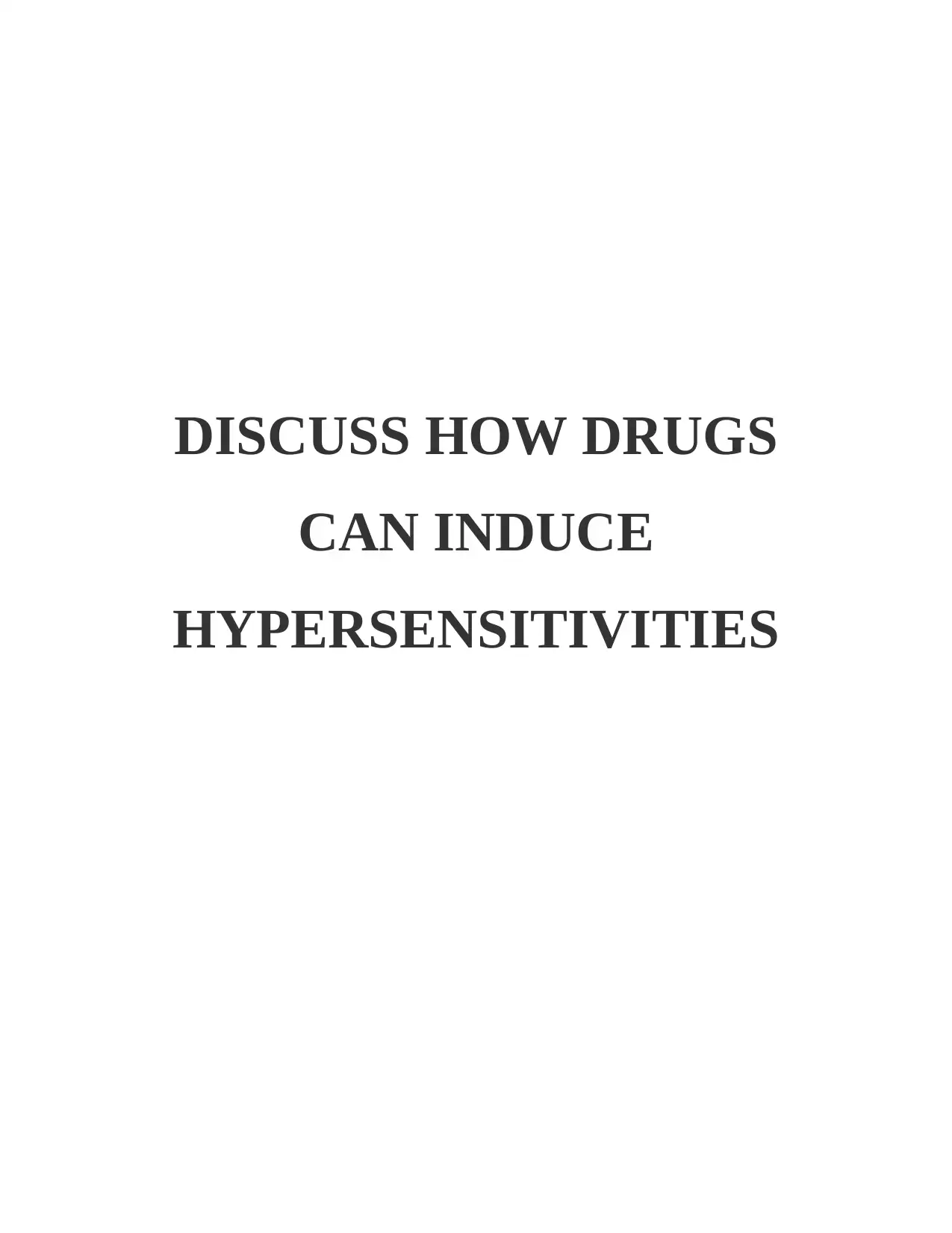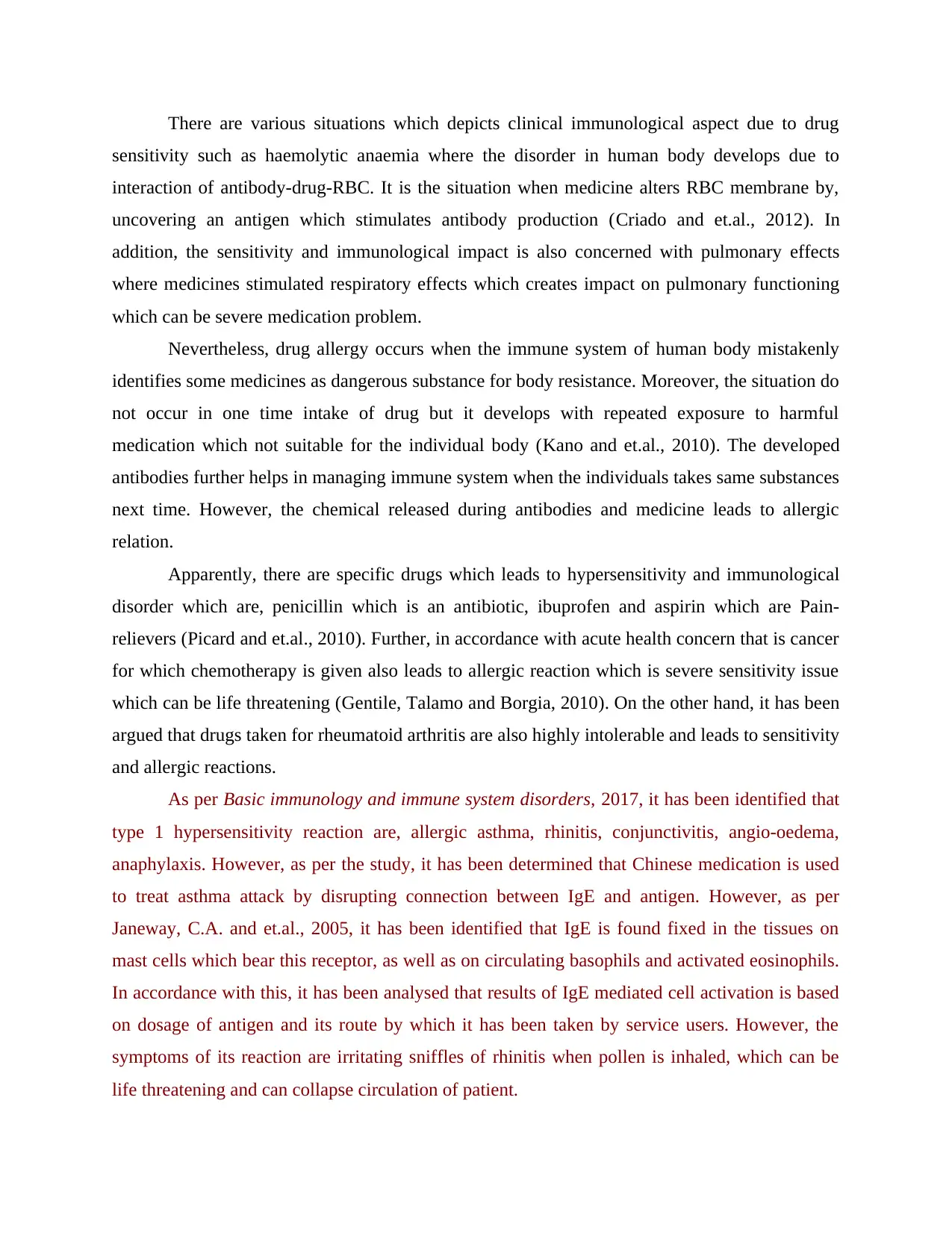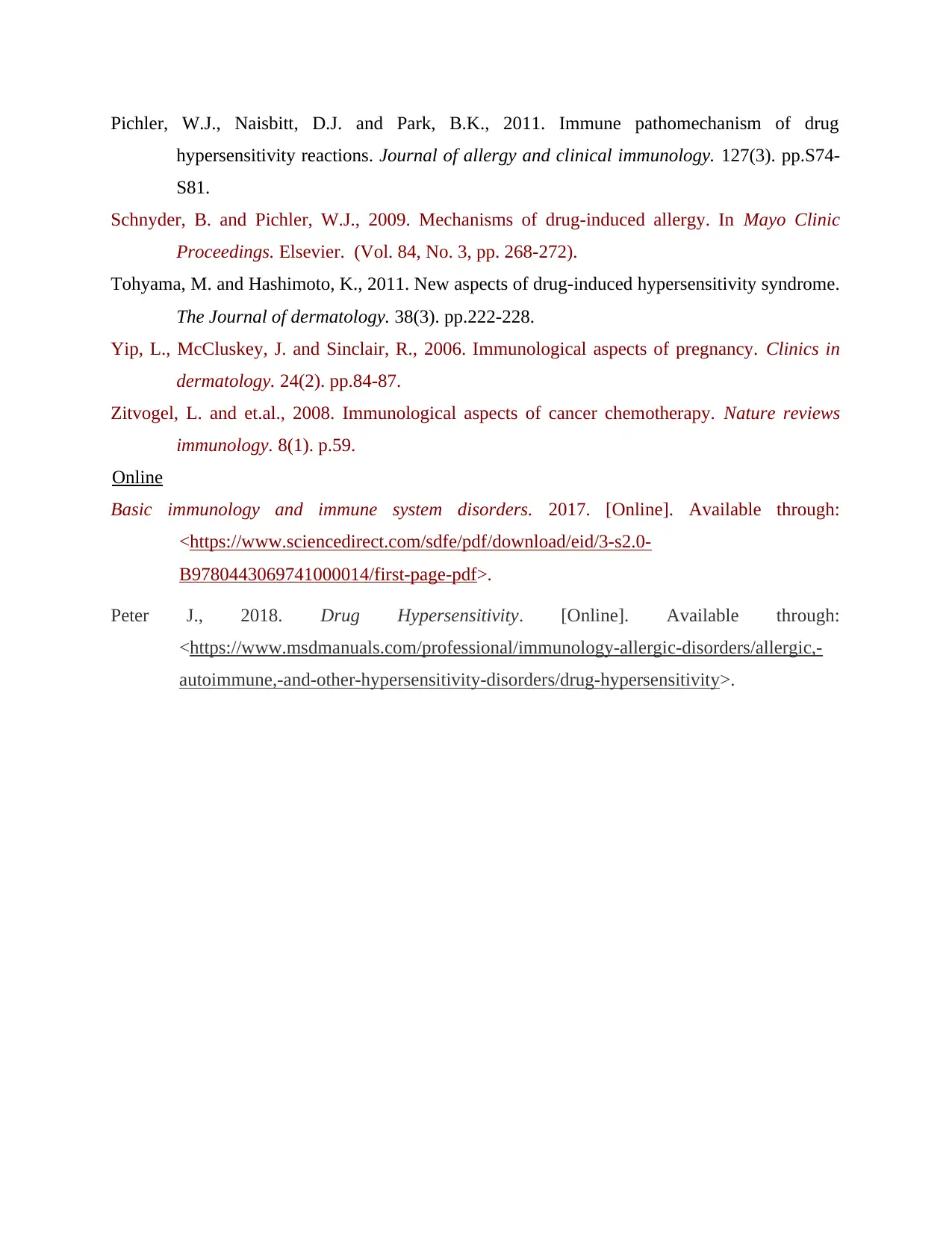Discussing How Drugs Can Induce Hypersensitivities: A Report
VerifiedAdded on 2020/11/23
|7
|1917
|335
Report
AI Summary
This report delves into the mechanisms by which drugs can induce hypersensitivities, which are immune-mediated reactions leading to various adverse effects. It explores how drugs, essential in clinical services, can trigger allergic reactions, ranging from mild rashes to severe conditions like anaphylaxis. The report examines the different types of hypersensitivity reactions (Type I, II, III), the role of the immune system, and specific drugs like penicillin and chemotherapy agents that are known to cause such reactions. It also addresses risk factors, clinical immunological aspects, and the impact of drug metabolism, genetic predisposition, and viral reactivation. The report emphasizes the importance of understanding these reactions for effective patient care and management, highlighting the need for careful consideration of drug interactions and individual patient sensitivities. It also references various studies and online resources to support its findings.

DISCUSS HOW DRUGS
CAN INDUCE
HYPERSENSITIVITIES
CAN INDUCE
HYPERSENSITIVITIES
Paraphrase This Document
Need a fresh take? Get an instant paraphrase of this document with our AI Paraphraser

Table of Contents
DISCUSS HOW DRUGS CAN INDUCE HYPERSENSITIVITIES.............................................3
REFERENCES................................................................................................................................6
DISCUSS HOW DRUGS CAN INDUCE HYPERSENSITIVITIES.............................................3
REFERENCES................................................................................................................................6

DISCUSS HOW DRUGS CAN INDUCE HYPERSENSITIVITIES
Drugs are the essentials for clinical and medication services as it helps in curing disease.
Drugs are the heart of health care and clinical services because it helps the professional in curing
diseases with the help of proper medication. Medicines are the practice of diagnosis and science
of treatment which helps in prevent health concerns (Hsia and et.al., 2014). In addition,
hypersensitivity is the term which reflects human body resistance of person with regard to
diseases and medication. However, it can be argued that medicines are cause of inducing
hypersensitivity in people because the individuals are becoming addicted to medication. This
dependency of society on drugs is impact the immunity and is resulting in hypersensitivity
syndrome (Peter, 2018).
As per Schnyder and Pichler, 2009, it has been analysed that drug hypersensitivities are
an immune mediated reactions which results in rashes, itching, anaphylaxis, vomiting, nauseas
and serum sickness. This sensitivity reaction of medicines can be either sever or mild (Doña and
et.al., 2011). Apparently, it can be said that the reason of hyper drug sensitivity can be
interaction of two or more types of medication. Similarly, drug hyper sensitivity syndrome is
relatively rare and it equally impacts immunity of males and females.
According to Zitvogel, L. and et.al., 2008, radiotherapy-based cancer and immunological
aspects of cancer chemotherapy treatment to body arise due to suppression of immune reactions.
However, as per Yip, McCluskey and Sinclair, 2006, immune aspect of pregnant women is
completely different where the females allow mothers to tolerate genetically different fetal
tissues during pregnancy. The alteration I pregnancy leads to impairment where cell mediated
immunity increases the risk infections such as tuberculosis, inflammatory skin disease etc.
Hypersensitivity due to drug dependency is caused due to problems in metabolism of
liver due to excessive drug intake. Moreover, it can be due to genetic predisposition of medicines
and re activation of human herpes virus 6 or Epstein Barr Virus (Park and et.al., 2011). Further,
it results in lacking immunity of human body due to which the service user become sensitive to
every change that is medication, climate, surrounding etc. Further, it can be said that sensitivity
to medicines is an immune mediate reaction where some proteins and large polypeptide drugs
like, antibodies, insulin, therapeutic etc. direct induce antibody production (Ben m'rad and et.al.,
2009).
Drugs are the essentials for clinical and medication services as it helps in curing disease.
Drugs are the heart of health care and clinical services because it helps the professional in curing
diseases with the help of proper medication. Medicines are the practice of diagnosis and science
of treatment which helps in prevent health concerns (Hsia and et.al., 2014). In addition,
hypersensitivity is the term which reflects human body resistance of person with regard to
diseases and medication. However, it can be argued that medicines are cause of inducing
hypersensitivity in people because the individuals are becoming addicted to medication. This
dependency of society on drugs is impact the immunity and is resulting in hypersensitivity
syndrome (Peter, 2018).
As per Schnyder and Pichler, 2009, it has been analysed that drug hypersensitivities are
an immune mediated reactions which results in rashes, itching, anaphylaxis, vomiting, nauseas
and serum sickness. This sensitivity reaction of medicines can be either sever or mild (Doña and
et.al., 2011). Apparently, it can be said that the reason of hyper drug sensitivity can be
interaction of two or more types of medication. Similarly, drug hyper sensitivity syndrome is
relatively rare and it equally impacts immunity of males and females.
According to Zitvogel, L. and et.al., 2008, radiotherapy-based cancer and immunological
aspects of cancer chemotherapy treatment to body arise due to suppression of immune reactions.
However, as per Yip, McCluskey and Sinclair, 2006, immune aspect of pregnant women is
completely different where the females allow mothers to tolerate genetically different fetal
tissues during pregnancy. The alteration I pregnancy leads to impairment where cell mediated
immunity increases the risk infections such as tuberculosis, inflammatory skin disease etc.
Hypersensitivity due to drug dependency is caused due to problems in metabolism of
liver due to excessive drug intake. Moreover, it can be due to genetic predisposition of medicines
and re activation of human herpes virus 6 or Epstein Barr Virus (Park and et.al., 2011). Further,
it results in lacking immunity of human body due to which the service user become sensitive to
every change that is medication, climate, surrounding etc. Further, it can be said that sensitivity
to medicines is an immune mediate reaction where some proteins and large polypeptide drugs
like, antibodies, insulin, therapeutic etc. direct induce antibody production (Ben m'rad and et.al.,
2009).
You're viewing a preview
Unlock full access by subscribing today!

There are various situations which depicts clinical immunological aspect due to drug
sensitivity such as haemolytic anaemia where the disorder in human body develops due to
interaction of antibody-drug-RBC. It is the situation when medicine alters RBC membrane by,
uncovering an antigen which stimulates antibody production (Criado and et.al., 2012). In
addition, the sensitivity and immunological impact is also concerned with pulmonary effects
where medicines stimulated respiratory effects which creates impact on pulmonary functioning
which can be severe medication problem.
Nevertheless, drug allergy occurs when the immune system of human body mistakenly
identifies some medicines as dangerous substance for body resistance. Moreover, the situation do
not occur in one time intake of drug but it develops with repeated exposure to harmful
medication which not suitable for the individual body (Kano and et.al., 2010). The developed
antibodies further helps in managing immune system when the individuals takes same substances
next time. However, the chemical released during antibodies and medicine leads to allergic
relation.
Apparently, there are specific drugs which leads to hypersensitivity and immunological
disorder which are, penicillin which is an antibiotic, ibuprofen and aspirin which are Pain-
relievers (Picard and et.al., 2010). Further, in accordance with acute health concern that is cancer
for which chemotherapy is given also leads to allergic reaction which is severe sensitivity issue
which can be life threatening (Gentile, Talamo and Borgia, 2010). On the other hand, it has been
argued that drugs taken for rheumatoid arthritis are also highly intolerable and leads to sensitivity
and allergic reactions.
As per Basic immunology and immune system disorders, 2017, it has been identified that
type 1 hypersensitivity reaction are, allergic asthma, rhinitis, conjunctivitis, angio-oedema,
anaphylaxis. However, as per the study, it has been determined that Chinese medication is used
to treat asthma attack by disrupting connection between IgE and antigen. However, as per
Janeway, C.A. and et.al., 2005, it has been identified that IgE is found fixed in the tissues on
mast cells which bear this receptor, as well as on circulating basophils and activated eosinophils.
In accordance with this, it has been analysed that results of IgE mediated cell activation is based
on dosage of antigen and its route by which it has been taken by service users. However, the
symptoms of its reaction are irritating sniffles of rhinitis when pollen is inhaled, which can be
life threatening and can collapse circulation of patient.
sensitivity such as haemolytic anaemia where the disorder in human body develops due to
interaction of antibody-drug-RBC. It is the situation when medicine alters RBC membrane by,
uncovering an antigen which stimulates antibody production (Criado and et.al., 2012). In
addition, the sensitivity and immunological impact is also concerned with pulmonary effects
where medicines stimulated respiratory effects which creates impact on pulmonary functioning
which can be severe medication problem.
Nevertheless, drug allergy occurs when the immune system of human body mistakenly
identifies some medicines as dangerous substance for body resistance. Moreover, the situation do
not occur in one time intake of drug but it develops with repeated exposure to harmful
medication which not suitable for the individual body (Kano and et.al., 2010). The developed
antibodies further helps in managing immune system when the individuals takes same substances
next time. However, the chemical released during antibodies and medicine leads to allergic
relation.
Apparently, there are specific drugs which leads to hypersensitivity and immunological
disorder which are, penicillin which is an antibiotic, ibuprofen and aspirin which are Pain-
relievers (Picard and et.al., 2010). Further, in accordance with acute health concern that is cancer
for which chemotherapy is given also leads to allergic reaction which is severe sensitivity issue
which can be life threatening (Gentile, Talamo and Borgia, 2010). On the other hand, it has been
argued that drugs taken for rheumatoid arthritis are also highly intolerable and leads to sensitivity
and allergic reactions.
As per Basic immunology and immune system disorders, 2017, it has been identified that
type 1 hypersensitivity reaction are, allergic asthma, rhinitis, conjunctivitis, angio-oedema,
anaphylaxis. However, as per the study, it has been determined that Chinese medication is used
to treat asthma attack by disrupting connection between IgE and antigen. However, as per
Janeway, C.A. and et.al., 2005, it has been identified that IgE is found fixed in the tissues on
mast cells which bear this receptor, as well as on circulating basophils and activated eosinophils.
In accordance with this, it has been analysed that results of IgE mediated cell activation is based
on dosage of antigen and its route by which it has been taken by service users. However, the
symptoms of its reaction are irritating sniffles of rhinitis when pollen is inhaled, which can be
life threatening and can collapse circulation of patient.
Paraphrase This Document
Need a fresh take? Get an instant paraphrase of this document with our AI Paraphraser

As per drug hyper sensitivity, there are various risk factors which be outlined such as
history of allergic reactions due to food intolerance, climate changes, particular substance. This
is the situation which is concerned to heredity and can not be controlled by medication. In such
situation it is importation for the person to be careful for intake of substance and intolerable food
item which can cause allergic reactions. In addition, hypersensitivity occurs of to high dosage
and repetitive exposer to same medication (Tohyama and Hashimoto, 2011). Thus, it can be said
that clinical immunological aspects are related to drug infections such as reaction with Epstein-
Barr virus or Human Immunodeficiency Virus.
Some immunologic drug reactions are, reaction type I that is known as IgE-mediated
occurs due to intake of β-lactam antibiotic and results in Anaphylaxis. However, type I reaction
usually occurs in time period of minute to hour after Medicine exposure. Type II is known as
Cytotoxic which is reflected in case of intake of Penicillin which result in Hemolytic anemia.
Further, immunologic drug reaction can be certain T cell stimulation which results in
Morbilliform rash due to intake of sulfonamides (Ang and et.al., 2010). However, Type III
reaction which occurs due to anti-thymocyte globulin reacts between 1 to 3 weeks of drug
revelation. Thus, with the discussion, it can be said that hyper sensitivity to drug reaction is
reflected according to immunity of human body ad also has particular time frame of reaction.
Hence, as per the discussion there are various types of risk for severe medication
reactions like, serious illness generally occurs to adults in case of reactions. Further renal
insufficiency is a state of medication which is due to HIV infection. Liver diseases occurs due to
Concomitant viral pathological process (Musette and et.al., 2010). Similarly, it can be stated that
the drugs which leads of hypersensitivity are great imitators and can be dangerous any organ of
human body. However, it is concerned with immunological aspect of clinical process because
reactions of medicines are commonly evident with dermatological symptoms that can be caused
by the metabolic and immunologic activity of the skin (Pichler, Naisbitt and Park, 2011).
history of allergic reactions due to food intolerance, climate changes, particular substance. This
is the situation which is concerned to heredity and can not be controlled by medication. In such
situation it is importation for the person to be careful for intake of substance and intolerable food
item which can cause allergic reactions. In addition, hypersensitivity occurs of to high dosage
and repetitive exposer to same medication (Tohyama and Hashimoto, 2011). Thus, it can be said
that clinical immunological aspects are related to drug infections such as reaction with Epstein-
Barr virus or Human Immunodeficiency Virus.
Some immunologic drug reactions are, reaction type I that is known as IgE-mediated
occurs due to intake of β-lactam antibiotic and results in Anaphylaxis. However, type I reaction
usually occurs in time period of minute to hour after Medicine exposure. Type II is known as
Cytotoxic which is reflected in case of intake of Penicillin which result in Hemolytic anemia.
Further, immunologic drug reaction can be certain T cell stimulation which results in
Morbilliform rash due to intake of sulfonamides (Ang and et.al., 2010). However, Type III
reaction which occurs due to anti-thymocyte globulin reacts between 1 to 3 weeks of drug
revelation. Thus, with the discussion, it can be said that hyper sensitivity to drug reaction is
reflected according to immunity of human body ad also has particular time frame of reaction.
Hence, as per the discussion there are various types of risk for severe medication
reactions like, serious illness generally occurs to adults in case of reactions. Further renal
insufficiency is a state of medication which is due to HIV infection. Liver diseases occurs due to
Concomitant viral pathological process (Musette and et.al., 2010). Similarly, it can be stated that
the drugs which leads of hypersensitivity are great imitators and can be dangerous any organ of
human body. However, it is concerned with immunological aspect of clinical process because
reactions of medicines are commonly evident with dermatological symptoms that can be caused
by the metabolic and immunologic activity of the skin (Pichler, Naisbitt and Park, 2011).

REFERENCES
Books and Journals
Ang, C.C. and et.al., 2010. Retrospective analysis of drug-induced hypersensitivity syndrome: a
study of 27 patients. Journal of the American Academy of Dermatology. 63(2). pp.219-
227.
Ben m'rad, M. and et.al., 2009. Drug-induced hypersensitivity syndrome: clinical and biologic
disease patterns in 24 patients. Medicine. 88(3). pp.131-140.
Criado, P.R. and et.al., 2012. Drug reaction with eosinophilia and systemic symptoms
(DRESS)/drug-induced hypersensitivity syndrome (DIHS): a review of current
concepts. Anais brasileiros de dermatologia. 87(3). pp.435-449.
Doña, I. and et.al., 2011. Characteristics of subjects experiencing hypersensitivity to non‐
steroidal anti‐inflammatory drugs: patterns of response. Clinical & Experimental
Allergy. 41(1). pp.86-95.
Gentile, I., Talamo, M. and Borgia, G., 2010. Is the drug-induced hypersensitivity syndrome
(DIHS) due to human herpesvirus 6 infection or to allergy-mediated viral reactivation?
Report of a case and literature review. BMC infectious diseases. 10(1). p.49.
Hsiao, Y.H. and et.al., 2014. Genotype–phenotype association between HLA and carbamazepine-
induced hypersensitivity reactions: Strength and clinical correlations. Journal of
dermatological science. 73(2). pp.101-109.
Janeway, C.A. and et.al., 2005. Immunobiology: the immune system in health and disease.
Kano, Y. and et.al., 2010. Visceral involvements and long-term sequelae in drug-induced
hypersensitivity syndrome. The Medical Clinics of North America. 94(4). pp.743-59.
Musette, P. and et.al., 2010. Treatment of osteoporosis: recognizing and managing cutaneous
adverse reactions and drug-induced hypersensitivity. Osteoporosis international. 21(5).
pp.723-732.
Park, B.K. and et.al., 2011. Drug bioactivation and protein adduct formation in the pathogenesis
of drug-induced toxicity. Chemico-biological interactions. 192(1-2). pp.30-36.
Picard, D. and et.al., 2010. Drug reaction with eosinophilia and systemic symptoms (DRESS): a
multiorgan antiviral T cell response. Science translational medicine. 2(46). pp.46ra62-
46ra62.
Books and Journals
Ang, C.C. and et.al., 2010. Retrospective analysis of drug-induced hypersensitivity syndrome: a
study of 27 patients. Journal of the American Academy of Dermatology. 63(2). pp.219-
227.
Ben m'rad, M. and et.al., 2009. Drug-induced hypersensitivity syndrome: clinical and biologic
disease patterns in 24 patients. Medicine. 88(3). pp.131-140.
Criado, P.R. and et.al., 2012. Drug reaction with eosinophilia and systemic symptoms
(DRESS)/drug-induced hypersensitivity syndrome (DIHS): a review of current
concepts. Anais brasileiros de dermatologia. 87(3). pp.435-449.
Doña, I. and et.al., 2011. Characteristics of subjects experiencing hypersensitivity to non‐
steroidal anti‐inflammatory drugs: patterns of response. Clinical & Experimental
Allergy. 41(1). pp.86-95.
Gentile, I., Talamo, M. and Borgia, G., 2010. Is the drug-induced hypersensitivity syndrome
(DIHS) due to human herpesvirus 6 infection or to allergy-mediated viral reactivation?
Report of a case and literature review. BMC infectious diseases. 10(1). p.49.
Hsiao, Y.H. and et.al., 2014. Genotype–phenotype association between HLA and carbamazepine-
induced hypersensitivity reactions: Strength and clinical correlations. Journal of
dermatological science. 73(2). pp.101-109.
Janeway, C.A. and et.al., 2005. Immunobiology: the immune system in health and disease.
Kano, Y. and et.al., 2010. Visceral involvements and long-term sequelae in drug-induced
hypersensitivity syndrome. The Medical Clinics of North America. 94(4). pp.743-59.
Musette, P. and et.al., 2010. Treatment of osteoporosis: recognizing and managing cutaneous
adverse reactions and drug-induced hypersensitivity. Osteoporosis international. 21(5).
pp.723-732.
Park, B.K. and et.al., 2011. Drug bioactivation and protein adduct formation in the pathogenesis
of drug-induced toxicity. Chemico-biological interactions. 192(1-2). pp.30-36.
Picard, D. and et.al., 2010. Drug reaction with eosinophilia and systemic symptoms (DRESS): a
multiorgan antiviral T cell response. Science translational medicine. 2(46). pp.46ra62-
46ra62.
You're viewing a preview
Unlock full access by subscribing today!

Pichler, W.J., Naisbitt, D.J. and Park, B.K., 2011. Immune pathomechanism of drug
hypersensitivity reactions. Journal of allergy and clinical immunology. 127(3). pp.S74-
S81.
Schnyder, B. and Pichler, W.J., 2009. Mechanisms of drug-induced allergy. In Mayo Clinic
Proceedings. Elsevier. (Vol. 84, No. 3, pp. 268-272).
Tohyama, M. and Hashimoto, K., 2011. New aspects of drug‐induced hypersensitivity syndrome.
The Journal of dermatology. 38(3). pp.222-228.
Yip, L., McCluskey, J. and Sinclair, R., 2006. Immunological aspects of pregnancy. Clinics in
dermatology. 24(2). pp.84-87.
Zitvogel, L. and et.al., 2008. Immunological aspects of cancer chemotherapy. Nature reviews
immunology. 8(1). p.59.
Online
Basic immunology and immune system disorders. 2017. [Online]. Available through:
<https://www.sciencedirect.com/sdfe/pdf/download/eid/3-s2.0-
B9780443069741000014/first-page-pdf>.
Peter J., 2018. Drug Hypersensitivity. [Online]. Available through:
<https://www.msdmanuals.com/professional/immunology-allergic-disorders/allergic,-
autoimmune,-and-other-hypersensitivity-disorders/drug-hypersensitivity>.
hypersensitivity reactions. Journal of allergy and clinical immunology. 127(3). pp.S74-
S81.
Schnyder, B. and Pichler, W.J., 2009. Mechanisms of drug-induced allergy. In Mayo Clinic
Proceedings. Elsevier. (Vol. 84, No. 3, pp. 268-272).
Tohyama, M. and Hashimoto, K., 2011. New aspects of drug‐induced hypersensitivity syndrome.
The Journal of dermatology. 38(3). pp.222-228.
Yip, L., McCluskey, J. and Sinclair, R., 2006. Immunological aspects of pregnancy. Clinics in
dermatology. 24(2). pp.84-87.
Zitvogel, L. and et.al., 2008. Immunological aspects of cancer chemotherapy. Nature reviews
immunology. 8(1). p.59.
Online
Basic immunology and immune system disorders. 2017. [Online]. Available through:
<https://www.sciencedirect.com/sdfe/pdf/download/eid/3-s2.0-
B9780443069741000014/first-page-pdf>.
Peter J., 2018. Drug Hypersensitivity. [Online]. Available through:
<https://www.msdmanuals.com/professional/immunology-allergic-disorders/allergic,-
autoimmune,-and-other-hypersensitivity-disorders/drug-hypersensitivity>.
1 out of 7
Related Documents
Your All-in-One AI-Powered Toolkit for Academic Success.
+13062052269
info@desklib.com
Available 24*7 on WhatsApp / Email
![[object Object]](/_next/static/media/star-bottom.7253800d.svg)
Unlock your academic potential
© 2024 | Zucol Services PVT LTD | All rights reserved.





